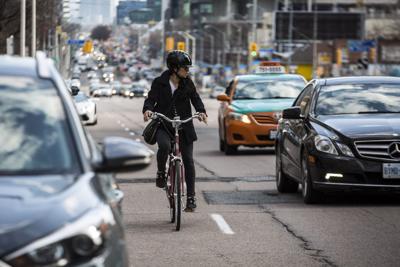Last Saturday afternoon I wandered into the ļ£Ĺ«…Á«ÝĻŔÕÝPublic Library Black Creek branch in North York Sheridan Mall. On the magazine rack was the current issue of Car and Driver magazine with the headline ‚ÄúWeapons of Choice‚ÄĚ and a photo of three luxury sedans being tested in race formation on the cover.
It was a shock to see. Cars and other vehicles have been used explicitly as weapons in attacks around the world¬†‚ÄĒ¬†like just this week in Japan¬†‚ÄĒ¬†and other drivers have caused an incredible amount of damage, human or otherwise, through carelessness and dangerous driving.
Later that evening news arrived from Vancouver that a driver rammed an SUV into the Filipino Lapu-Lapu Day festival crowd killing 11 and injuring dozens more. I thought of the cover again and ever since: Weapons of choice.
Car and Driver was right, but not the way it meant: beyond intentional attacks, drivers in cars, SUVs and trucks threaten the safety of our public spaces everyday but we treat the damage they do like the weather: something inevitable that just happens.
For Torontonians, Vancouver had the dreadful feeling of déjà vu with . Reminders of that are never far away in Toronto. Sometimes it’s an event, like a few weeks ago, when a driver used his car as a weapon at TMU, triggering the collective hair on the back of our necks to stand up as we wondered if the downtown pedestrianized campus was going to be another horrific scene. Luckily it wasn’t.
Then there are the static reminders, like the temporary and ugly barriers around Union Station that were finally replaced with clunky concrete ones a little less ugly. Or at major events like Pride or the film festival, where dump trucks, buses and other city vehicles are positioned to protect people. The sight of everyday infrastructure marshalled into defensive positions gives me an odd feeling of gratitude and sadness: the city is doing what it should to protect us, but is this really the state of things?
With attacks, vehicles are used as intentional weapon, but consider how urban roads are designed for speed ‚ÄĒ highways through populated parts of the city. Or how aggressive the look and styling of vehicles have become, with angry snouts that make them look like birds of prey or something akin to military hardware. And car commercials and media that celebrate combative behaviour and needless engine power.
This is a kind of weaponization too.
It’s that kind of culture that allows a car magazine to come up with an unironically shocking cover, but also why it’s so hard to do anything about the problem. Between the attacks and the everyday carnage, we ought to start thinking about this like gun violence in the U.S.: a choice not to do much about it.
As cars, SUVs and trucks become bloated, growing in size so they‚Äôre more dangerous to everyone else, including other drivers, cities like ļ£Ĺ«…Á«ÝĻŔÕÝhave busied themselves banning things like e-scooters. Meanwhile e-bikes often have speed limiters though motor vehicles don‚Äôt. The priorities are clear.
Then there’s road design itself. After I put Car and Driver back on the shelf, I navigated the mall parking lot with barely any safe provision for pedestrians over to the corner of Wilson Avenue and Jane Street. A beast of an intersection, typical of the GTA, vehicles speed through mere centimetres from sidewalks busy with people moving between plazas or waiting at bus stops, all with no protection.
Efforts to prevent attacks are good, but we do relatively little to mitigate risks other drivers create. Beyond the green and red light intervals, the latter routinely run by drivers nearly every cycle, nothing at Wilson and Jane slows drivers or forces them to behave in ways that makes the adjacent public realm feel less precarious.
For years I‚Äôve taken my U of T urban civics students on a field trip to Yonge Street in North York. Though predating the van attack, our route traces it in reverse, from Mel Lastman Square up to Finch Avenue. We discuss the attack, but also that despite tens of thousands of people living here along Yonge it’s still highwaylike with relatively few safe crossings, a condition that encourages pedestrians to cross in between the far off signalized intersections.
Then we discuss how the plan to create a better and safer public realm along this stretch called ‚Äú‚ÄĚ has been delayed, denied and debated for nearly a decade, leaving a dangerous status quo in place.¬†
We make valiant efforts to prevent attacks at events, but in ļ£Ĺ«…Á«ÝĻŔÕÝand elsewhere we should admit that we are very much OK with a certain amount of death and life-changing injuries in order to not inconvenience driving.
That is also a weapon of choice, but one we have pointed at ourselves.


























To join the conversation set a first and last name in your user profile.
Sign in or register for free to join the Conversation